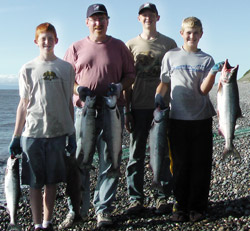Fresh and Frozen
October 15, 2010
For years, making a living on the ocean seemed like a dream to Lance Alldrin. As a young man he had the opportunity to visit Alaska, and, as he pursued a career as a high school teacher in Chico, California, he kept the possibility of going back to fish there firmly in mind.
career as a high school teacher in Chico, California, he kept the possibility of going back to fish there firmly in mind.
In 2005, Lance bought several permits to fish in Kenai, Alaska, and he and his family have gone back every year. As lance puts it “salmon fishing sites themselves are similar to a gold mining claim: new net sites can be pioneered in vacant areas of water or you can buy an established lease.”
“Not many people do what they dream to do, but I’ve been lucky to have a supportive wife and kids to help me crew,” he says. Lance’s oldest son Caleb (17), has spent six summers with him in Alaska; his two younger sons, Tim and Luke, joined in this year. Together the family sells wild salmon under the name Alldrin and Sons Alaska Salmon.
Sustainable Catch
“It certainly would have been easier [at the time] to have pursued commercial fishing out of Monterey Bay or Fort Bragg,” says Lance. “It would have been cheaper and more convenient, but the sustainability model doesn’t exist here in California like it does in Alaska.”
All commercially caught seafood in Alaska is certified sustainable by the Marine Stewardship Council (MSC). In the areas that allow commercial fishing, fishermen are allowed to set nets only when a sufficient number of salmon have been counted as they return up the river; the state’s Fish and Wildlife Deptartment has been using a sonar system to keep track of the salmon since the early 1980s, which has resulted in one of the most healthy remaining wild fisheries in the world.
Lance also likes fishing in a state that doesn’t dam the rivers (also a stipulation of the Alaskan constitution). “The waterways there are managed not for agriculture or residential use, but to make sure that all fish species have uninterrupted access to their home rivers.”
Sub-Zero Hero
On the days when the Alldrins get the go ahead from the Fish and Game scientists to catch salmon, they take the fish to a processor that cuts and flash-freezes it, and a portion of what they catch gets shipped to their Chico home where they are stored in a walk-in freezer powered by solar energy. Lance sells the fish frozen because it stays as fresh as if it were caught the day before, but he’s finding that shoppers are slow to catch on.
“When I see fish sitting in a cold case I know it is either already a few days old because of the shipping time, or it’s been frozen and has already defrosted in the case,” he says. And yet, many shoppers are wary. The key, says Lance, is allowing the fish to defrost slowly in a refrigerator, not in a microwave, which will dry it out.
One recent study by the nonprofit Ecotrust found that frozen fish generally has a smaller carbon footprint than fresh fish because it can be transported slowly by freighter or train, which use significantly less fossil fuel than airplanes. According to Ecotrust, “The choice to buy frozen matters more than choosing organic over conventional or wild instead of farmed.”
Look for Alldrin and Sons in the Saturday market. They’ll be stationed next to Cowgirl Creamery this week; starting next week they’ll be in the spot where Shogun Fish Company has been (Shogun leaves for the season).
